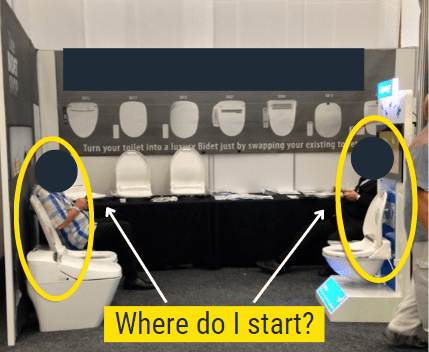Let me start with this…
You know when you’re on a phone call with someone and you can tell they’re typing… Isn’t it just THE most annoying thing in the world? It’s distracting and just plain rude.
In an exhibition environment, this behaviour is equivalent of parents “watching” their kids on the sports field with a phone glued to their hand. If you aren’t present. It’s truly felt.
Visitors might not want to be pounced on, but how your team handle themselves sets you up for incredible success or epic failure.
Side note: I was at a trade show once and this actually happened***

As a visitor, would you honestly go up to either of these guys to discuss their product? I applaud them for keeping their space open, but they are far from inviting.
As a manager, you know the importance of staff training for exhibitions. It’s an opportunity to showcase your company’s products and services, and you want your team to be knowledgeable and confident when interacting with potential customers.
But let’s be honest, getting your staff excited about training for exhibitions can be a challenge. The mere mention of it might cause them to shrink into their chairs and avoid eye contact. So, how do you get your team engaged and eager to learn?
Your team might think they know better, but what we have found is that when some of the basics are further built upon, trade show performance can improve tenfold (OK, that stat is made up, but I wanted to make it sound important. It’s REALLY important).
Standard team training might look something like this:
- No talking on the phone
- No eating on the stand
- No checking your emails… or your socials. (Whether we do it or not is another story).
- Smile
- Greet people warmly
- Use open ended questions
These are important, but they are also common sense. We read body language, talk, mirror, greet, wave and interpret our way through every single day. We KNOW how to be nice (my three year old does too).
The significant investment a company makes in attending a trade show isn’t for a staff field trip. The reason why staff don’t jump for joy at the idea of manning a stand is mostly because they don’t understand (or believe in) the true potential of a show.
Regardless of what KPI’s you set, most attened exhibitions are to strengthen relationships with customers and would-be customers but, if 64% of attendees are NOT customers** so the opportunity to meet new clients is phenomenal.
That’s with zero cold calling or unreturned voicemails… Visitors shake your hand, get a sense of your brand and then it’s up to you what unfolds, but they come to you! Which is brilliant when 29% of all attendees at trade shows do not see reps*.
So in my opinion… (If you’re a regular reader you know I like to have an opinion), manning a stand should be considered the crème de la crème of prospecting. It’s totally up to staff how they engage their audience and what impression their visitor leaves with.
How to use body language at trade shows
Body language forms a huge part of our daily lives. I guarantee that if this single aspect of staff training is improved, you WILL return from a show with MORE LEADS.
Without assessing the intentions of those around us we’re forgoing a vital human trait that helps us stay safe. We unconsciously translate millions of messages and scan faces to assess threats. Embrace this natural instinct at an exhibition!
Have you ever misinterpreted a text message/email simply because you didn’t hear the tone used? It does come naturally to some, but it’s actually a learned skill. Something magical happens when you know what to look for!
By actively reading body language and the interactions of people around you, you’re more likely to address visitors with the RIGHT level of service.
Bottom line is, the attendee will think you’re wonderful and you won’t find yourself chewing the ear off anyone who doesn’t genuinely care about your product. It’s a win win. (This blog is a great starting point if you want to build better relationships at trade shows).
Make a conscious effort to read your audience
Train staff to interact face-to-face on an exhibition stand. Unlike any other medium, the audience comes to you. You can’t hide behind an email or a phone line.
Some companies don’t even like to see reps, which means the outcome of the exhibition is even more important. Respect it.
The 3 key signs a visitor is interested:
- Head up, ready to talk
- Looking at or holding an item – If they are not currently speaking to a salesperson, this is an open invitation to speak to them.
- They are mirroring your body language – This is a non-verbal way to say “I’m like you”, they want to hear more and be your friend.
Keep it real
You’re going to scare people off if you pounce on them like a second hand car salesmen. (I’m sure you know that, but it upsets me to see it – It’s like when you see something bad happen and time seems to warp so you see it unfold in slow motion).
On the flipside. If a sales person doesn’t approach a visitor, they can also interpret this as a bad experience because they don’t feel serviced.
To strike the right balance you will rely HEAVILY on reading body language. The objective is for you and your team to look approachable without being overly eager. Authenticity wins every time!
In fact, 56% of what attendees remember is not the message on the stand, the gimmick or the give away. It is the quality of their interaction with staff*.
In other words, the HUMAN ELEMENT.
7 ways to be more authentic when manning your stand:
- Smile – People buy from people they know, like and trust.
- Open body language – Don’t cross arms, legs or hide behind counters (if your visitor is crossing their arms or legs crossed while standing – Unless they are cold, they aren’t comfortable and are trying to make their presence smaller… Either lay off them or let them leave)
- Ask open-ended questions like; “What product are you currently using?” “What does your current setup look like?”
- Create a experiential imprint – How could you make their day just that little bit better?
- Don’t stand behind a counter
- No sitting at tables unless you’re actually meeting with a customer/visitor. (No-one cares if you have sore feet).
- Be available – don’t stand in pairs or groups
Which reminds me…
Typically sales reps don’t get to hang out with their colleagues much so an exhibition can seem like a fabulous opportunity to make up for missed water cooler gossip. When I see groups of co-workers huddled like this I can’t help but cringe. This is not the reason to attend a show!
This is why staff training for exhibitions is vital. It isn’t until you highlight this stuff that it’s top of mind.
Exhibitions can’t be seen as a play day away from regular work duties. It’s a sea of potential leads that are washing up at your feet. The opportunity cost is enormous.
Experiment for Greater Results
Treat your stand like a behavioural experiment. If something isn’t working, you have the power to change things. My recommendation is to treat your exhibit like a lab, working in 15min blocks test out a few different things. This technique can help you turn around a dud show.
Changing your behaviour every 15min may actually help you get back on course without getting to the end of the show and realising what you have been doing hasn’t worked.
If you see attendees as part of a homogeneous group, experimenting for 15min will not wreck your trade show success, but not changing for the whole day could.
Some things you could experiment with:
• “What if I hold this in my hand?”
• Display different material on your digital signage
• Ask different opening questions
• Change where you are standing
If you want to discuss team training for your next event, or talk about any challenges you might be facing, I’m happy to help. You know where to find me!
Yours in Exhibiting,
Jess
*** Yes, they really are sitting on toilets!
**exhibitsurveys.com
* CIER
